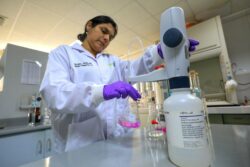Health Puzzles Unveiled: Persistent Effects of Toxic Water Contamination
The prevalence and ramifications of toxic water contamination present a significant global health concern.

This article explores the prominent contaminants, their chronic health impacts, illustrated through real-life scenarios.
Additionally, preventive strategies and mitigation measures against water contamination are scrutinized to propagate awareness and prompt action towards this escalating public health issue.
Key Takeaways
- Toxic water contamination can originate from various sources such as industrial waste disposal, agricultural runoff, untreated sewage discharge, and chemical spills.
- The manifestation of water contamination can include changes in water taste or color, abnormal plant growth, and affected aquatic life, with the potential for bioaccumulation of toxins in organisms' tissues leading to chronic illnesses.
- Effective policies, such as the use of Geographic Information Systems (GIS) to track contaminant spread, are crucial in mitigating water contamination at its source.
- Hazardous elements like lead, arsenic, and mercury pose significant health risks, and their detection can be done through methods like mass spectrometry or atomic absorption spectroscopy. Additionally, emerging threats from unregulated chemicals like pharmaceuticals and personal care product residues need to be addressed.
Understanding the Scope of Toxic Water Contamination

Exploration of the magnitude and implications of toxic water contamination necessitates a comprehensive understanding of its origins, spread, and long-term health impacts. The importance of identifying Contamination Sources cannot be overstated. These may include industrial waste disposal, agricultural runoff, untreated sewage discharge, and chemical spills. Each source introduces different toxins into water bodies that subsequently permeate ecosystems and affect human health.
Contamination Manifestation occurs when these toxins infiltrate our drinking water sources through groundwater seepage or surface run-off. Such manifestation is evident in various ways - from subtle changes in water taste or color to more significant indicators like abnormal plant growth or affected aquatic life. Even minuscule amounts can lead to serious health issues over time if ingested regularly.
Toxic compounds found in contaminated water often bioaccumulate within organisms' tissues, leading to chronic illnesses such as cancer, neurological disorders, or reproductive problems. This points towards the dire need for effective policies to mitigate contamination at its source.
Additionally, tracking the spread of toxic contaminants helps determine their impact radius and severity level. Advanced tools such as Geographic Information Systems (GIS) have been instrumental in mapping out areas vulnerable to contamination based on proximity to identified sources.
The Chemical Culprits: Common Contaminants in Water

Understanding the nature and impact of common contaminants in aquatic environments requires a thorough investigation into chemical culprits such as lead, arsenic, and mercury. These elements are naturally occurring but become hazardous when concentrations exceed safe limits due to anthropogenic activities, thus necessitating effective contaminant detection methods.
Lead poses severe health risks at high levels, causing neurological disorders and cognitive impairments. Arsenic is associated with skin lesions and increased risk of cancers, while mercury exposure can affect the nervous system severely. Advanced techniques like mass spectrometry or atomic absorption spectroscopy provide reliable information about these contaminants' prevalence and concentration.
Chemicals regulation policies play a crucial role in maintaining water quality standards. The U.S., for instance, enforces the Safe Drinking Water Act (SDWA) which sets maximum contaminant levels for numerous pollutants including lead, arsenic, and mercury. However, variations exist internationally regarding acceptable contamination thresholds indicating the need for greater policy harmonization.
Emerging threats from unregulated chemicals further complicate matters. Contaminants like pharmaceuticals or personal care product residues are increasingly detected in water bodies worldwide requiring enhanced monitoring strategies. Current methods struggle to detect some of these substances due to their relatively low concentrations despite potential cumulative effects on ecosystems and human health.
Tracing the Health Impact: From Exposure to Chronic Conditions

Investigating the relationship between exposure to chemical contaminants and the onset of chronic conditions provides essential insights into their pervasive impact on public well-being. A growing body of evidence points towards a strong correlation between these two variables, suggesting that prolonged contact with toxic substances can lead to disease development in numerous cases.
Research studies indicate that once ingested, certain contaminants act as endocrine disruptors, thereby interfering with normal hormonal function, which could result in various health disorders including cancers, neurological conditions or cardiovascular diseases. The specific outcomes often depend upon factors such as exposure duration and individual genetic susceptibility.
The concept of genetic susceptibility plays an integral role in this context. Certain individuals are genetically predisposed to developing diseases when exposed to particular environmental toxins. Therefore, it is not just the presence of chemicals but also the human genetic makeup that determines the disease outcome.
Moreover, there is mounting evidence linking early life exposures to specific chemical contaminants with chronic non-communicable diseases later in life. This highlights the potential for long-term health impacts from acute exposures during critical windows of development.
Case Studies: Real-Life Scenarios of Water Contamination Effects

Real-life scenarios of exposure to harmful substances, as depicted in numerous case studies, illustrate the serious consequences of such incidents on both individual and community well-being. These cases often involve complex interactions between contamination origins and subsequent health effects.
The Flint Water Crisis exemplifies such a scenario. The decision to switch the city's water supply led to lead poisoning among its residents, demonstrating how decisions concerning infrastructure can serve as contamination origins. Despite existing legal frameworks designed to safeguard public health, lapses in their enforcement precipitated this crisis.
Another instance is the Minamata disease incident in Japan where industrial wastewater contaminated with methylmercury discharged into Minamata Bay resulted in severe neurological syndromes among local inhabitants and wildlife. This case highlights that contamination origins can also stem from industrial processes despite stringent environmental regulations.
Both these instances underscore not only the vital importance of understanding contamination origins but also the role of comprehensive legal frameworks in preventing similar crises. They demonstrate that legislation alone is insufficient if not coupled with effective implementation and rigorous monitoring mechanisms.
These case studies provide a sobering reminder of the potential for harm when humans are exposed to toxic contaminants due to failures at multiple levels—be it decision-making regarding infrastructure, oversight of industrial activities or implementation of protective laws. Ultimately, they underline an urgent need for robust scientific research dedicated towards tracing contamination pathways and understanding chronic health effects thereof. Moreover, they emphasize an immediate requirement for strengthening legal frameworks so as to avoid future episodes of widespread public health impacts due to water contamination.
Strategies for Prevention and Mitigation of Water Contamination

Strategies for the prevention and mitigation of detrimental substances in aquatic environments encompass a variety of approaches. These include improved infrastructure development decisions, rigorous oversight on industrial activities, effective implementation and monitoring of protective laws, and robust scientific research dedicated to tracing contamination pathways. This becomes particularly critical against the backdrop of rising global concerns about fresh water scarcity.
The role of Contamination Legislation cannot be overstated in this context. Such legislation forms the crux of regulatory control over potential sources of pollution. It regulates industrial effluents discharge, agricultural runoffs, household waste disposal, among others. Contamination legislation sets enforceable standards for water quality and mandates regular testing to ensure compliance. However, it is often observed that while legislations are comprehensive on paper, they can fall short during execution due to lack of resources or political will. Therefore, strengthened enforcement mechanisms paired with public awareness campaigns can significantly elevate the effectiveness of these legislations.
Parallelly, advancements in Filtration Technologies offer promising solutions for eliminating contaminants from water bodies. These range from traditional methods like sedimentation and filtration to more advanced technologies such as activated carbon treatment, reverse osmosis, and nanofiltration. The choice of technology typically depends upon factors like nature and concentration levels of pollutants along with cost-convenience considerations.
In conclusion, an integrated approach combining stringent contamination legislation with cutting-edge filtration technologies could form a potent strategy for tackling water contamination issues effectively.
Thus far, strategies have centered around controlling point-source pollution. However, future efforts would need to address non-point source pollution, which remains largely unregulated yet contributes significantly to the overall aquatic pollution load.
Frequently Asked Questions
What Are the Economic Impacts of Toxic Water Contamination on a Community?
Toxic water contamination has significant economic impacts on communities, necessitating costly Contamination Mitigation measures. Additionally, increased spending on Health Interventions to address resultant health issues can strain local economies and public resources.
How Does Toxic Water Contamination Contribute to Global Environmental Changes?
Toxic water contamination contributes to global environmental changes by disrupting aquatic ecosystems, causing biodiversity loss. Further, ineffective contamination legislation exacerbates these changes by failing to mitigate the pollution and its far-reaching effects.
Can Individuals Build a Resistance to the Effects of Toxic Water Contaminants Over Time?
Research indicates that while some organisms can develop 'Contaminant Tolerance', humans typically cannot. Filtration Systems are crucial for reducing exposure, as chronic consumption of toxic water leads to long-term health complications.
What Are Some Historical Examples of Toxic Water Contamination and How Were They Handled?
Historical instances of toxic water contamination, such as the Love Canal incident and Flint Water Crisis, were addressed through various mitigation strategies, including remediation efforts and changes in policy addressing contamination sources.
Is There Any Technological Advancement That Can Detect Toxic Water Contamination at Its Earliest Stage?
Technological advancements have facilitated early detection of toxic water contamination. Contamination prevention strategies include advanced filtration systems that use real-time monitoring to identify and eliminate harmful substances at the initial stages of contamination.
Conclusion
In conclusion, toxic water contamination presents a significant health risk globally. Comprehensive understanding of common contaminants and their long-term impacts is crucial.
Case studies underscore the gravity of this issue while suggesting preventive and mitigative strategies as potential countermeasures.
Continued research in this area remains imperative for ensuring safe, clean water—a fundamental human necessity—thus protecting public health from these persistent hazards.

This post has been generated by AI and was not reviewed by editors. This is Not legal advice. Please consult with an attorney.




